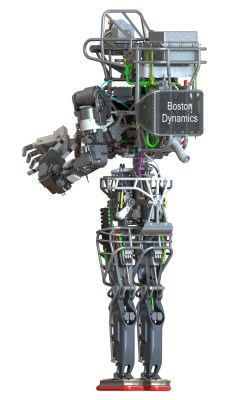[youtube=http://www.youtube.com/watch?&v=zkBnFPBV3f0]
Don’t be afraid, because while DARPA’s towering 330-pound, six-foot two-inch tall Atlas robot may look like a snaking cable and machined metal metropolis — the lovechild of Johnny Five and a flayed T-800 — the only reason it exists is to protect and serve flimsy organic lifeforms like you and me.
Welcome to the end of the prelude to the beginning: the official unveiling of a sophisticated human-sized bipedal rescue robot rigged by the wizards at Boston Dynamics for the DARPA Robotics Challenge. DARPA took the wraps off Atlas at Boston Dynamics HQ yesterday, putting the robot through its paces and demonstrating its human-like arms, legs, torso, head (with laser rangefinder and stereo sensors) and hands (two swappable sets) in action — all linked by 28 hydraulically actuated joints.
Atlas includes an onboard computer, hydraulic pump and the ability to manage its temperature, plus a tether (like a tail) that carries 480V three-phase power at 15 kW (sounds like the real challenge down the road is going to be getting a big enough battery into this thing). No, Atlas isn’t as visually impressive as Guillermo del Toro’s Brobdingnagian “Jaeger” mechs in Pacific Rim, but then Atlas only has to be capable of subbing for human emergency responders, not smashing skyscraper-sized mutant beasts crawling out of cracks in the Pacific ocean floor to stomp on the West Coast.
We’re nine months into DARPA’s two year build-a-robot-savior contest (it launched last October), where teams have been competing on various tracks to design agile and durable mechanical servants capable of going where most humans wouldn’t dare, say exploring a collapsed mine to help rescue trapped miners, neutralizing explosive devices, or working in contaminated areas after accidents like Fukushima, Chernobyl and Three Mile Island.
The DRC isn’t some pro bono show-and-tell, either: the winning team pockets $2 million. But to win, a robot has to be capable of performing tasks like driving a utility vehicle, climbing a wobbly industrial ladder, shattering a concrete wall using a power tool, crossing a debris-littered field, isolating and closing a valve in a leaking pipe and replacing damaged or dated industrial equipment. Simple as some of those sound, today’s robots can do virtually none of those things.
You might say a version of Atlas is already on the fast track to win, because the way this works, the seven DRC Track B and C teams that won DARPA’s Virtual Robotics Challenge late last month (26 teams from eight countries competed) by tweaking a virtual version of Atlas, now receive their own physical Atlas robots to fiddle with in the lead-up to the DRC Challenge Trials (where they’ll compete against each other, as well as other Track A teams working on their own non-Atlas robots). That plays out this December at Florida’s Homestead-Miami Speedway with an event that’ll be open to the public, after which the final contestants will compete for the grand prize in DARPA’s December 2014 “final Challenge event” involving an “end-to-end disaster-style scenario.” (I vote for having to navigate Michigan’s roads, which are among the worst in the country.)
“The Virtual Robotics Challenge was a proving ground for teams’ ability to create software to control a robot in a hypothetical scenario,” said DRC program manager Gill Pratt in DARPA’s official press release. “The DRC Simulator tasks were fairly accurate representations of real world causes and effects, but the experience wasn’t quite the same as handling an actual, physical robot. Now these seven teams will see if their simulation-honed algorithms can run a real machine in real environments. And we expect all teams will be further refining their algorithms, using both simulation and experimentation.”
How capable is Atlas at this point, pre-challenge? According to DARPA (via IEEE Spectrum), we’re talking about a robot roughly on par with the motile competence of a one-year-old child (I can relate to the analogy, because I’ll have one of those by the end of this month and he’s into everything). That said, IEEE Spectrum was at the event in person and described the demonstration as “underwhelming” given what Atlas is eventually going to have to do to meet the challenge’s requirements. But what about after the seven teams have finished modifying their Atlas robots for the challenge trials? DARPA says to expect a leap to the mobile competence of a two-year-old, which, given all I’ve read two-year-olds can do, would be impressive mojo indeed.
What of the Track A groups creating their own non-Atlas robots to square off with the seven VRC team winner? In its press release, DARPA said it visited and evaluated designs details as well as, in a few instances, “completed robots,” from which it selected six teams to advance to the DRC trials and receive continued DARPA funding, among them a pretty darned cool animal-esque robot we’ve featured here, dubbed CHIMP.
“We have dramatically raised the expectations for robotic capabilities with this Challenge, and brought together a diverse group of teams to compete,” said Pratt in DARPA’s press release. “The progress the Track A teams have made so far is incredible given the short timeline DARPA put in place. From here out, it’s going to be a race to the DRC Trials in December, and success there just means the qualifying teams will have to keep on sprinting to the finish at the DRC Finals in 2014.”
And we’ll definitely be watching.



